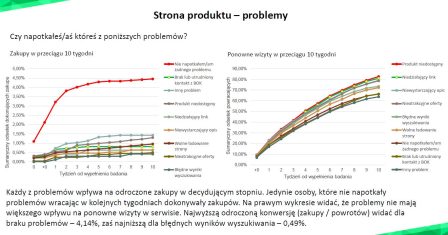The Impact of User Experience and Issues on Conversion
User experience has a direct impact on website conversion performance. Problems encountered during a visit—whether technical, related to information availability, or usability—can discourage users from completing a purchase or taking the desired action.
With YourCX, you can not only collect user feedback about issues, but also measure how those experiences influence user behavior and ultimately affect business outcomes.
How Do Experiences Affect Conversion?
Users who encounter issues (e.g. form errors, missing information, slow loading times) are more likely to abandon the session or exit their shopping cart.
Satisfaction with the visit directly influences the decision to continue along the purchase path.
Low ratings in surveys often correlate with specific stages of the user journey that are poorly optimized or frustrating.
YourCX Data and Conversion – What Can You Analyze?
Goal completion: Did the user achieve their visit goal? This can be assessed via survey responses and behavioral data (e.g. whether they proceeded to checkout).
Reported issues among non-converters: What do non-converting users report—e.g. high shipping costs, missing payment options, technical errors?
Drop-off triggers: Which page elements or stages are most often linked to session abandonment, as seen through user journeys and survey timing?
Group comparison: Do satisfied users (those who give high scores) convert more frequently than dissatisfied ones?
Best Practices for Analyzing CX Impact on Conversion
Collect contextual feedback – for example, after cart abandonment or a session without purchase.
Ask about visit goals and whether they were achieved – this allows comparison between user expectations and actual outcomes.
Link survey data with behavioral data – such as user journey paths, time on site, or number of steps before abandonment.
Segment your findings – analyze how different user groups (e.g. new vs. returning visitors, desktop vs. mobile users) react to the same issues.
Act quickly on critical issues – use YourCX alerts or integrations with ticketing systems to address urgent problems.
Example:

Issues and Delayed Purchases
YourCX analyses show that users who did not encounter any problems are significantly more likely to complete a purchase—even at a later time.
For example, on a product page:
Users who experienced no issues reached a delayed conversion rate of 4.14% within 10 weeks after the survey.
In contrast, users who reported incorrect search results converted at the lowest rate—only 0.49%.
This demonstrates that even a single issue can drastically reduce the likelihood of purchase—not only during the current session, but also in the future.
Issues and Return Visits
The chart also indicates that while problems have a smaller impact on return visits than on conversions, the effect is still noticeable:
Users may return to the site, but with lower engagement (e.g., they do not complete their purchases).
Those who report product availability issues or non-functioning site elements are less likely to make further purchase attempts.